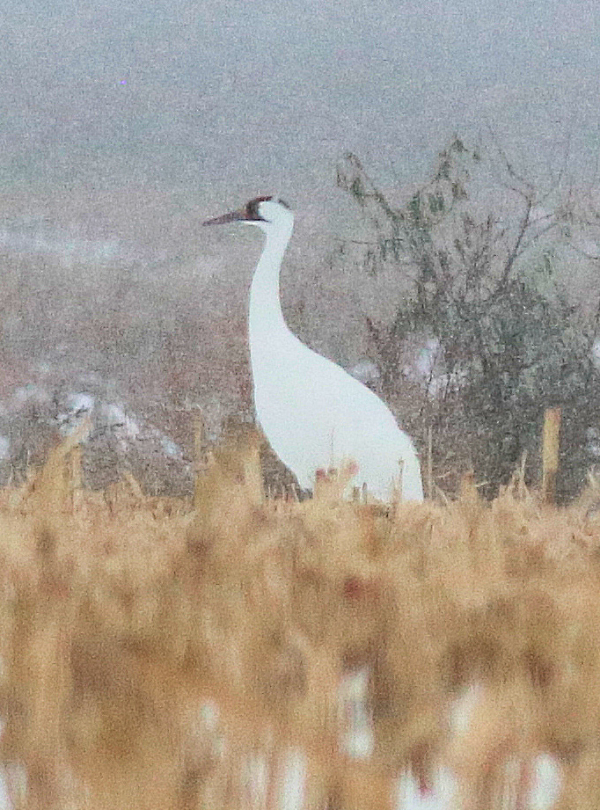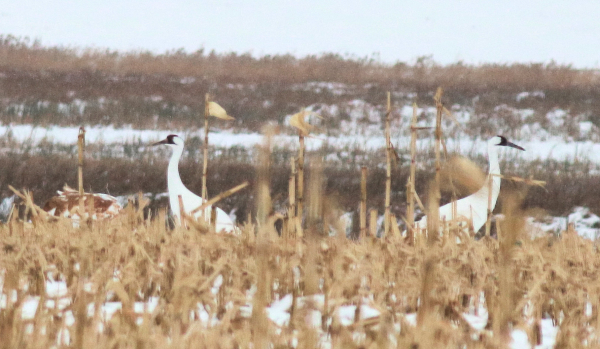
Observing an ultra-rare endangered species is exciting, and studying the activities of a Whooping Crane family group during a migration stopover is an ultimate birding experience for some.

As the afternoon progressed, snow began to fall again, leaving a somber setting for this photo of an adult Whooping Crane.

The family group that stopped over at Sand Lake National Wildlife Refuge in northeast South Dakota was resting, feeding, and preparing for the next segment of its migration from northern Alberta to coastal Texas. (The back of the feeding young Whooper can barely be seen at the far left side of this photo.)
|
For a few years I’ve been hoping to see Whooping Cranes in the area, either along the Missouri River, which is a familiar flyway for these rare and endangered birds, or in the open plains east of the river. So last Friday, I was absolutely aghast as I realized I had missed a great opportunity to see five Whooping Cranes that spent a number of days at a favorite wildlife refuge, Sand Lake National Wildlife Refuge, which is about 70 minutes southeast of my office. I was dumbfounded by my bad luck that hinged on the fact that I only check for rare bird sightings once per week – each Friday. When I checked the list serves for each of the Dakotas last Friday, my jaw must have dropped as I gasped when I saw the posts I missed for Whooping Cranes at Sand Lake; darn!
The first report was posted Monday, October 19th when a local birder reported the 5 Whoopers feeding in a harvested cornfield near the south side of the refuge. In hindsight, it’s actually good I didn’t know about it Monday or Tuesday because I had an absolute publishing deadline to meet. But I certainly would have made a streak to Sand Lake Wednesday morn if I had been aware of the Whooping Cranes.
The Aberdeen birder also posted reports to confirm they were still present Tuesday and Wednesday, so my chances were excellent – had I known. Of course, it’s my own fault, but there was a big snowfall overnight Wednesday and early Thursday, which may have pushed the cranes south ahead of the storm, or after it. My biggest miss of the fall season – maybe the year – really haunted me. I don’t chase rare birds usually, but I do revel at the opportunity to document Whooping Crane sightings; and if you have ever seen Whooping Cranes during migration, you understand that the feeling is similar to sighting a bright meteor and you understand my excitement about the chance of such an encounter, but . . .
Whooper Thrills
Saturday morning I checked the SoDak listserve to see if there was an update on the Whoopers, but seeing none, I emailed the birder who posted the sighting information earlier in the week. Within the hour, Barry emailed me the best message I’ve received in a long time: “They are there today,” and he provided his telephone number and suggested I call him if I wanted more information. I called, pretty immediately, and was excited to hear about the Whoopers through the week, including that they had been sighted that morning. Barry explained there were two pairs of Whooping Cranes and that one pair was attending a young of the year. (We also had an interesting visit beyond the cranes, having almost crossed paths a couple times during our early professional careers.)
Obviously, I dropped everything and took off for Sand Lake Refuge, despite the light snow that was beginning to fall. This was too good to miss, and the feeling of disappointment experienced the night before suddenly changed to a spirit of elation. About 70 miles down the road, I began a general search of the area, working my way toward the last place the Whoopers were sighted.
Just north of a prominent Bald Eagle nest, complete with an attendant pair of Bald Eagles, I spied a familiar tall white bird, then another! I exhaled deeply, and checked the Whooping Cranes out through binoculars, appreciating their avian aura; then realizing a young crane was with them. Colored similarly to the dry corn and snow, the patchy white and orange-ish plumage of the first fall Whooper blended perfectly with its surroundings as it fed with its head down.
It was great fun to observe the Whooping Cranes in the not-too-distant distance. Often during migration, Whooper sightings offer little more than mere white spots that are far too distant to get very excited about. These birds were close enough to appreciate their size and enjoy watching their every move. I took a few documentary photos of the Whooping Cranes, the first I’ve seen in South Dakota, and the first I’ve seen in a number of years. The young bird had its head down almost all the time, eating voraciously and making it almost impossible to get a good photo of the three cranes with their heads elevated and turned just right at the same time.
As I watched, it began to snow, at first very small flakes showed, but the more time I watched, the larger the flakes became and the more it snowed. Finally I had to give in and headed for home, but not without vowing to return if the sun came out Sunday.
Sunshine Sunday
Sunday provided an abundance of sunshine, so I hustled back to Sand Lake with high hopes of photographing the Whoopers in prime light – if they had not resumed their migration after their morning feeding session. The day before, I didn’t see two of the Whooping Cranes reported earlier in the day, but about 3:30 Sunday afternoon I sighted the two Whoopers as they took flight from the floodplain marsh and watched them through binoculars as they flew west almost a half-mile until they banked low and landed gracefully in an open, snow-covered field. They slowly walked in long strides to a harvested cornfield where they fed for the rest of my stay, looking like two white spots in the far distance – typical Whooping Cranes during a migration stopover on the Great Plains.
As it turned out, the family group of Whoopers was no more accommodating. I observed them fly up from the marsh toward the harvested cornfield where they fed Saturday afternoon, but I lost sight of them before they landed. As I imagined, they landed on the far edge of the field, in a hidden fold in the hill where I could not see them from area vantage points – until I was about to call it quits. That’s when I sighted the trio slipping across an opening that revealed their feeding movements for a few moments before the landscape seemed to engulf them. “Oh well,” I thought, “I’ll try again Wednesday, if they persist as SoDak Whooping Cranes.”
Even though Sunday’s observations were subdued after the excitement of finding and photographing the Whooping Cranes in documentary fashion Saturday, it was another memorable chapter in “my book of cranes.” In addition to the 2 North American species, I’ve studied 11 other species of cranes – all the species in the world except Black-necked Cranes and Demoiselle Cranes. Cranes have taken me to Africa and Asia as a researcher, and I enjoyed them in Australia as a birder. Of all the world’s cranes, Whooping Cranes stand out as very special birds in this big world! My only regret about the South Dakota Whoopers is that I didn’t hear them call, for the loud trumpeting baritone calls of Whooping Cranes are among the most dramatic sounds in nature.
Article and photos by Paul Konrad